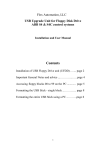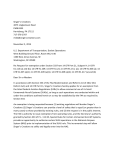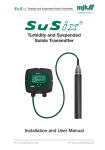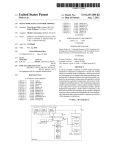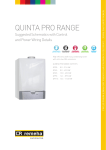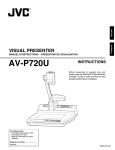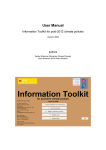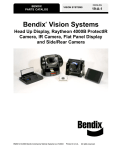Download Airspace and Range Scheduling Management Appendix B (Flight
Transcript
Airspace and Range Scheduling Management Appendix B (Flight Planning Guide) Range Airspace and Planning In preparation for UAS operations support at FAA designated UAS Test Site range(s), the operations department requires technical and planning data prior to commencement of any operation. This data will be used to coordinate, plan, cost, and execute your project and is required at least 60 calendar days prior to commencement of operations under either a Certificate of Waiver or Authorization (COA) or a Special Airworthiness Certificate (SAC). Project Overview 1. Objectives: Demonstration and market survey 2. Description: Target identification 3. Capabilities: ISR General Information 1. Organization Name: Lockheed Martin MST 2. Address: 1801 State Route 17C, Owego, NY 13827 3. POC: Todd Kopl 4. Phone numbers: 607-751-6752 5. Email: [email protected] Scheduling Information 1. 2. 3. 4. 5. 6. What is the anticipated number of flights and durations: 20 flts @ 40 min each What is anticipated time on station: 40 min What are the optimum calendar blocks of time for your operations? 11/3-7/2014 Day or night operations: Day Can you operate or train on weekends? If necessary What altitudes are required for your flight operations (in MSL and AGL)? 10 to 500’ AGL, 1004 MSL (typ) 7. To what range or distance from the launch point do you require for your flight operations? 1 nm typical 8. Who is the ultimate customer/sponsor of your flights or training? Various military and government agency customers (US and international), public service, commercial. 9. How many support personnel do you anticipate on station? 2 10. How many non-support guests do you anticipate on station? 30 11. Is this a classified project? No 12. Classified level N/A 13. If classified will you need special handling, storage, or communications support and if so please specify? N/A 14. List any other requirements/support required (i.e. targets/structures/activities to observe as well as any other logistical/administrative requirements). None 15. Frequency Bands: 1010 MHz to 1280 MHz 16. Do you have DD Form1494s or other FCC documentation for the data-links? (If so, please forward). Not required - FCC Part 15 radio 17. Take Off roll length: 0 (zero) 18. Landing roll distance required: 0 (zero) 19. Type of surface required: solid 20. Weather Limitations: Day VFR (typ); Moderate Rain (<7 mm/hr); wind 25 mph; humidity 100% non-condensing Launch Phase Mission Phase Recovery Phase Minimum Ceiling VFR VFR VFR Minimum Visibility VFR VFR VFR Maximum Headwind Component 25 25 25 Maximum Tailwind Component 25 25 25 Maximum Crosswind Component 25 25 25 Maximum Overall Wind Limit for Operations 25 25 25 Maximum Operating Temperature 120 F 120 F 120 F Minimum Operating Temperature -30 F -30 F -30 F Figure 1. Weather Conditions Affecting Operations *** Please include any special weather information that may affect your operations. For example cold, wet conditions; hot, dry conditions; humidity; icing; wind shear; heavy rain; turbulence; etc. Aircraft 1. User Handbook - Is user handbook/operator’s manual available? If so, please attach. LMPT Indago User Guide V1.1.pdf 2. Physical Characteristics: a. UAS System Name: Indago b. Measurements - wingspan, fuselage length, body diameter 30 in 8.75 in tall c. d. e. f. g. h. i. j. k. Composition/construction material: composite Weight - empty and max load: 4 lb empty/5 lb max Fuel - type and capacity: N/A Gross takeoff weight with full load: 5 lbs Fuel Volume/Endurance: 45 min Fuel MSDS Available? (If so, please attach). N/A Battery Systems/Types: high-‐density lithium batteries Battery MSDS Available? (If so, please attach). Not available Brakes - tail hook or hydraulic? N/A 3. Propulsion System a. Engines - type, number, manufacturer, horsepower rating, electrical power source • N/A - (4) electric motors b. Fuel Volume and Consumption Monitors: • • Fuel gauge on battery Battery life displayed in minutes remaining on GCS c. Limitations and Failure Modes d. By environmental conditions (temperature, icing, dust) e. Confirmed by test data f. Considered in test plan 4. Performance Characteristics a. Performance Charts Maximum Cruise Speed: 26 knots Minimum Cruise Speed: 0 knots Approach Speed: (N/A, hovering aircraft) b. c. d. e. f. g. h. i. Takeoff and Landing: (N/A, hovering aircraft) Distances for maximum weights: 5 km Maximum crosswind tolerance: 25 mph Maximum Altitude: 18,000’ Maximum Endurance: 45 min Maximum Range: 5 km Range vs. Altitude (glide): (N/A, hovering aircraft) Airspeed - cruising, maximum, minimum, and stall Maximum Cruise Speed: 26 knots Minimum Cruise Speed: 0 knots Approach Speed: (N/A, hovering aircraft) j. Rate of Climb and Descent Climb Rate: 800 ft/min Descent Rate: 400 ft/min Turn Rate: 60 deg/sec k. Weather Minimums: Day VFR i. Clouds ii. Instrument Flight Rules (IFR) conditions: N/A 3. Flight Reference Data a. On-board sources of position, altitude, heading, altitude, and airspeed information to the UAS operator or autopilot : Displayed on ground control station hand controller b. Backups: laptop computer 6. Transponder - Does the UAS have an on-board transponder with Mode C altitude reporting? No 7. Payload Options - What payload capabilities will be used on the UAS during operations? a. Dimensions of payload(s): 3x3.25x3.5 in b. Weight of payload(s): 180 g c. Power requirements: (1) Air vehicle battery powers everything d. Towing or drop items: N/A 8. Hazardous Materials - Please list all materials that require special handling, such as flammable, toxic, energy storage, or ordinance. Include flight termination system if applicable. N/A Command and Control Systems Please describe the systems/methods used to control the UAS during flight; include frequencies where appropriate. 1. Control Method - primary and secondary H andcontroller U ser Interface The Handcontroller user interface provides the operator with critical system information, live Indago payload video, map of the operational location, and mechanisms for user input (touchscreen buttons and gestures as well as mechanical switches). Windows and Touchscreen Buttons A map and video window for operator situational awareness are displayed in the top left and bottom right of the user interface. The video window is small and the map window large. Note that the video and map window location and size are easily swapped by simply pressing on the smaller of the two windows in the touchscreen. Six touchscreen buttons located above the main window (i.e., larger of the two windows) are provided to the operator. A set of six buttons is dedicated to both the map and video windows. These two sets of six buttons are interchanged when the map and video windows are swapped. The touchscreen buttons are assignable, providing the operator easy access to functions associated with monitoring either the Indago’s video feed or the map. Refer to Section 4.2 of the attached User Guide. 2. Satellite or Line of Sight Line of Sight 3. Frequency Allocation a. Is there a frequency allocation for all RF links? Yes b. On what frequencies do the UAS systems operate? 1010-1280 MHZ c. What is the effect of radio frequency interference on the command and control system? – Loss of Communication may occur if interference is encountered. Preflight checks verify good communication with the rotorcraft. If communication is lost, lost-comm protocols are active. 4. Command Link Range a. What is demonstrated range of primary and backup command and control system systems? 2Km b. Backup - Is there a backup command transmitter and receiver No i. Does the backup have the same effective radiated power? ii. Is the backup link sufficiently protected from spurious command signals? 5. Link Analysis a. Has RF link analysis been performed to verify that both primary and backup transmitters can communicate with vehicle at furthest point of planned operation? Ground checks to perform integrity confirmation of data link prior to operation b. Does link analysis address all RF links? – N/A i. Uplinks from primary and backup ground stations? ii. Secondary uplinks from each ground station? iii. Downlinks to primary and backup ground stations? iv. Flight termination link? • Is there at least 12 dB of signal excess in FTS link? • How do you determine if the vehicle primary and backup command and control receivers and FTS receivers are operating at specified sensitivity? v. Does link analysis consider RF horizon? vi. Maximum range for each link? vii. How do you determine if the primary and backup transmitters are radiating specified output power? viii. Masking • Are there any nulls in the command transmitter antenna pattern? • Are there areas of RF masking due to location of antennas on the UAS relative to their position and to ground station antennas? • Are there any RF null spots in the command link based upon the position or orientation of the UAS relative to the control station? • Do the operators know where these nulls are? ix. Multipath • What is the link susceptibility to multipath? • What is the system response if multipath is experienced? 6. Takeoff and Landing a. What is the method? Launch procedure is as follows: 1. 2. 3. 4. 5. 6. 7. Unpackage system components Turn on Hand Controller Unfold vehicle by extending arms and landing legs Open end of battery compartment and insert battery to power up vehicle Place vehicle on a flat open area Perform preflight procedure When link is established, arm motors and enter launch mode from the Hand Controller Recovery procedure is as follows: 1. 2. 3. 4. 5. 6. Enter land mode Disarm motors Remove battery from air vehicle Turn off Hand Controller Collapse vehicle Pack all components in cases b. Navigation System i. What is the source of navigation information for the operator? GPS ii. Are there redundant sources? Yes, visual monitoring only Operations 1. Crew a. Requirements - Please list the total number of personnel involved in the mission and their associated job functions. 2 (PIC and observer) b. Experience - Detail the crew's flight qualifications, experience, and currency with this UAS. How recently did each crewmember fly this type of UAS? Todd Kopl (PIC) • • • • Private Pilot (Current), original date of issue 1995 Class II Medical (current) 90 day currency in manned/unmanned aircraft Currency on the following UAS platforms o Lockheed Martin Indago (Oct 2014) o Lockheed Martin Desert Hawk III (Oct 2014) o Lockheed Martin Desert Hawk IIIK (Oct 2014) o Lockheed Martin Desert Hawk EER (Dec 2013) o Lockheed Martin Vector Hawk (Oct 2014) Richard Powell (observer) • Private Pilot (Current) • Class II Medical • 90 day currency in manned/unmanned aircraft • Currency on the following UAS platform o Lockheed Martin Desert Hawk III (Sept 2014) • In-Training o Lockheed Martin Indago c. Safety - What information does the crew have to make safety related decisions? • • • • • Weather briefing Aircraft position at all times Transceiver radio Observer looking for other aircraft & reporting position System Warnings – refer to Section 8 of the User Guide 2. Pre-Flight a. Set-up Time - Upon arrival, how much set-up time is required to prepare for initial flight? 2 minutes b. Pre-Flight Checks -- Describe typical ground checks for the UAS and control system. Indago_Flight_Check list.pdf c. Launch - Please describe the takeoff procedure and handoff method in detail. Launch procedure is as follows: 1. Unpackage system components 2. Turn on Hand Controller 3. Unfold vehicle by extending arms and landing legs 4. Open end of battery compartment and insert battery to power up vehicle 5. Place vehicle on a flat open area 6. Perform preflight procedure When link is established, arm motors and enter launch mode from the Hand Controller d. Recovery - Please describe the recovery and landing procedure in detail. Recovery procedure is as follows: 1. 2. 3. 4. 5. 6. Enter land mode Disarm motors Remove battery from air vehicle Turn off Hand Controller Collapse vehicle Pack all components in cases e. Turnaround Time - Describe any required post-flight maintenance and the turnaround time between missions. Vehicle inspection, battery replacement, and mission upload – depending on landing state 2-20 minutes. Follow this procedure when subsequent flights are performed the same day: 1. Check props for dings, cracks, and abnormalities. 2. Check prop tension. 3. Check motor bell for excessive slop/grittiness. 4. Pull up on the motor bells to check that the motor shaft retaining clips are still in place. 5. Check that no screws are missing or loose. 6. Verify that landing gear is positioned and locked. 3. Failure (Risk) Management The autopilot failsafes handle failure conditions including Loss of Communications, Loss of GPS, and Low Battery conditions – and are set by default for a generic Indago mission profile. Additional system warning indications and responses are defined in Section 8 of the User Manual. 4. Safety History - not available a. Flight history b. Mishap history - Please list the mishap history of the UAS including major failure modes. How many crashes or failures have occurred? c. Corrective actions taken for past mishaps? 5. Demonstrated Reliability/Estimated time between mission failures? not available a. Calculated from analytical or empirical data? b. Environmental and performance limitations used to estimate reliability figures? 6. Hazard Analyses not available a. Have you completed a risk assessment for the proposed operation? If so, please enclose a copy with your reply. b. Please describe the methodology used and whether the RA is generic in nature or specific to the UAS and proposed operating range. 7. Software a. Software safety program – The autopilot software is commercial in support of SUAV operation. b. Software controlled components - What flight-critical components are software controlled? – autopilot control functions c. Analyses - Have any software safety analyses been performed? - No 8. Loss of Command and Control Link –see operators manual Section 5.8 a. Describe what happens when the command link is lost. Include UAS actions and flight crew actions. Option 1: Let Loss of Communication Failsafe run its course. If properly configured for the mission no harm should be done to the vehicle. Option 2: Troubleshoot the situation. Handcontroller: Check antenna connections and orientation Indago: Determine line-of-sights and altitude conditions Mission: Consider landing as soon as possible Comm link:Troubleshoot issues b. How does the vehicle respond if the command link is never re-established? This failsafe is activated if communication with the VC is lost while in a guidance mode. The user can specify a timer before the Stage 1 action is taken (e.g., 30.0 seconds ). a. This is helpful in the event the user needs to quickly swap the battery powering the laptop running the ground station software. In addition, the user can decide whether the Kestrel 3 Autopilot should Fly to Rally or Fly Home in an effort to regain communication with the ground station. b. In Stage 2, the user can again choose a timer (i.e. 30.0 seconds) and a behavior from three options: Land at Land Wpt, Land at Home, and Do Nothing (Land at Land Wpt or Land at Home to be used for operation). c. Recognition of loss - Operator and UAS i. How does the operator recognize loss of the command link? Via display status ii. How does UAS recognize loss of the command link? Via monitored communication timeout d. Back-up Command and Control - How is backup control initiated? N/A. 9. Loss of navigation a. How does the UAS and vehicle autopilot respond to a loss of navigation signal? A loss of GPS while in a Guidance mode will cause the Kestrel 3 Autopilot to hover using onboard sensors only and its position will likely drift. After a user-defined timeout (e.g., 10.0 seconds as shown in above figure), the Kestrel 3 Autopilot will land the vehicle at its current location. b. How is a primary navigation loss indicated to the ground station and operator? Via Guidance Mode Display and Failsafe status display. c. Back-up navigation N/A i. Is there a secondary navigation system? No ii. Does the UAS operator have access to any external sources of position information that could serve as a backup (radar, IFF, binoculars)? Direct Visual Monitoring d. If the UAS operator loses primary position information, is control also lost? No 10. Return home modes a. Conditions that cause return home mode Low Battery, Loss of Comm b. Location point, path, and altitude i. Selection • Safeguards to prevent erroneous selection Home position is set based on GPS position of unit at takeoff or at requested reset, it is not a data entry. • Ability to update in-flight – No ii. Intermediate waypoints - No iii. Multiple points – N/A iv. Airspace boundaries and compatibility – N/A v. Line of sight from control station Vehicle will directly navigate to the home point. All operations are within visual LOS. c. Vehicle action and sequence of events upon reaching return home point i. In event operator does not regain control ii. Fail-safe events iii. Landing Vehicle will land once it reaches the Home point and timers have expired d. Navigation during return home mode in event GPS is unavailable or jammed Vehicle will hover if GPS is lost. If not restored in a lost comm case, the vehicle will land at the hover location. Position may drift in hover due to loss of GPS. e. Pre-flight check Refer to Section 6 of the User Guide 11. Loss of Flight Reference Data - What are the indicators to the UAS operator, and how does the vehicle respond to losses of primary sources for position, altitude, heading, and airspeed? The autopilot failsafes handle failure conditions including Loss of Communications, Loss of GPS, and Low Battery conditions - display indications are provided for system operating issues. 12. Unresponsive Flight Controls a. If a servo or flight control sticks or becomes unresponsive i. What will happen? ii. How does the autopilot respond? iii. Is there a backup? iv. How quickly will the UAS respond? v. How will the operator recognize this? The UAV does not have servo controlled flight control surfaces. If a motor becomes non-responsive, the controls would attempt to compensate with the remaining motors within their control range. If not able to compensate, the UAV will land immediately at its current location, with limited control ability. Operator will observe the response and associated display warnings for the specific failure indication. b. What happens if the throttle is stuck? i. How will the UAS operator recognize this condition? ii. Is there a recovery procedure? The autopilot would attempt to compensate with the other motors within their control ranges. If not successful the UAV will land at its current location. Operator will observe the response and associated display warnings for the specific failure indication. 13. Loss of Propulsion a. How does UAS respond to engine failure? It lands immediately at its current location. b. Can engine be restarted in flight? Yes – but probably too late to mitigate the outcome c. Is electrical power lost? - No d. Will there be sufficient velocity and electrical power for "controlled ditch" or "dead-stick landing?" N/A – rotorcraft will immediately descend to ground 14. Loss of Electrical Power - Answer for electrical systems on UAS and again for control stations. a. Describe UAS response if electrical power is lost. UAS is electrically powered a loss of electric power causes the UAV to land immediately. Loss of power for GCS will cause loss of Comm failsafe activation. b. Describe any back-up electrical systems and expected operating time. What happens if the UAS is too far away to make it back before this time? It will land immediately at its current location. Ground station can also run on ground power in addition to battery. c. Battery i. Time life - Approximately 45 min / Ground station 4.5 hours ii. Life meter - battery state is displayed to operator iii. Log - No iv. Bus - Are there essential buses for reduced power operations and are all flight essential systems on this bus? - No v. Usage data on telemetry – Yes, battery status is displayed to the operator vi. Pre-flight check - Yes d. Uninterruptible power source for ground operations – No, loss comm timers support time to replace ground operation battery if optional ground power not used e. Backup command and emergency systems protection - No f. Does load shedding occur if power is lost? - No g. Flight information calculations - No h. Are there any effects on the flight termination system? – N/A 15. Subsystem Failure a. Failures that result in abort High Vibration Detected – persistent Excessive Vibration Detected - persistent b. Failures that result in UAS unable to fly Battery Faults: Cell Imbalance Permanent Fault Cell Undervoltage Permanent Fault ESC Faults Red-Green Alternating Flash on a Motor Pod Kestral 3 Autopilot Faults in Message Window Motor Pod Missing Sensor Failures during pre-flight 16. Flight Termination System (FTS) – Not Provided – Land Immediately can be commanded a. FTS function b. FTS activation i. How is the FTS activated? ii. Does it activate if battery backup fails? iii. Does it operate on independent battery circuit? iv. Activation authority c. Flight termination criteria i. Tracking data ii. Lack of containment in operating range iii. Return home failure iv. UAS below RF horizon v. Sequence of events after activation • Propulsion terminated • Parachute vi. Monitoring vii. Transmitter • Location • Range (exceed maximum flight range) viii. Testing and certification ix. Independence from other vehicle systems • Antenna • Receiver • Signal processing • Power supply x. Fail Safe Mode • Activation criteria • Sequence of events upon activation • Time delay between activation and sequence of events xi. Parachute • Deployment altitude • Impact and drift rate • Rate of descent at max weight • Deployment limitations o Altitude o Airspeed o Attitude • Weight-on-gear inhibit o Testing o Status telemetry to ground • Engine shutoff o Requirement o Failure of engine shutdown o Can propeller cut shroud line 17. Ditching – Operating area support ditching by commanding land immediate if operational issue cannot be addressed by the pilot. a. Criteria b. Pre-planned locations i. Selection and criteria ii. Free of population iii. Attainable from any point in flight path 18. Collision Avoidance -Describe procedures utilized for collision avoidance, including UAS response time to flight change commands. UAS will be directly monitored and flight coordinated with ATC and other operators. Altitude operation will support remaining clear of other traffic, defined holding areas utilized and as a last resort the UAV can be commanded to land immediately. a. Airspace i. Exclusive or shared ii. Compatibility with other aircraft or missions iii. Risk reduction to other aircraft iv. Manned aircraft communication b. Flight Routes i. Consideration of published standard approaches and departures ii. Standoff distances • Densely populated areas • Hazardous sites • Civilian airfield • Planned into return home mode c. DSA d. Collision Prevention Markers (lights, strobes, TCAS, bright paint) Nav Lights e. Loss of IFF N/A i. Procedure ii. Notification of ground operator f. Chase Aircraft N/A i. Standoff distance ii. Continuous surveillance and procedure if lost iii. Communications between UAS, chase pilot and ground safety 19. In the event of a crash, could a crash cause a fire? Not likely, but some potential if severe damage occurs to the battery. Ground Support 1. Ground Control Stations (GCS) - Please describe the ground stations involved in the UAS operations. Include mission control stations, launch/recovery stations and payload control stations as appropriate. For each GCS list: a. Function of station b. Desired placement location (i.e., in hangar, on runway) c. Power and infrastructure requirements d. What happens if power is lost See User Guide 2. Logistics Support - For each item below, please list exact requirements and how facility/equipment will be used: N/A a. Hangar facilities (in square feet) b. Office space c. Telephone requirements (number of lines) d. Computer equipment (number of workstations, printers, internet access) e. Handheld communications (number of units and channels required) f. g. h. i. Fuel Tow/support vehicles Portable generators Classified handling/security provisions Configuration Management All changes to the UAS will be logged. Any changes to the UAS will be evaluated by Site Operator to determine if the airworthiness statement is still valid. Air Traffic Service Provider Coordination/Communication A specific plan for communicating with the controlling and adjacent Air Traffic Service providers will include contingency plans, phone numbers and any other pertinent information as designated by the parties involved. Public Relations 1. Do you intend to issue a news release upon completion of your UAS/payload flight operations? If not, are you opposed to NIAS-PMO and/or joint news release distributed with your permission, respecting your trademarks and copyrights? Coordinate all news release items with Lockheed Martin. 2. Who is your public relations point of contact? Jeff Brown 607-751-2796 Email completed form to: XXXXXXXXXXXXX - Unmanned Aircraft Systems, Management Office.

















